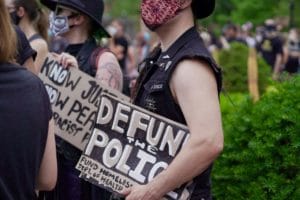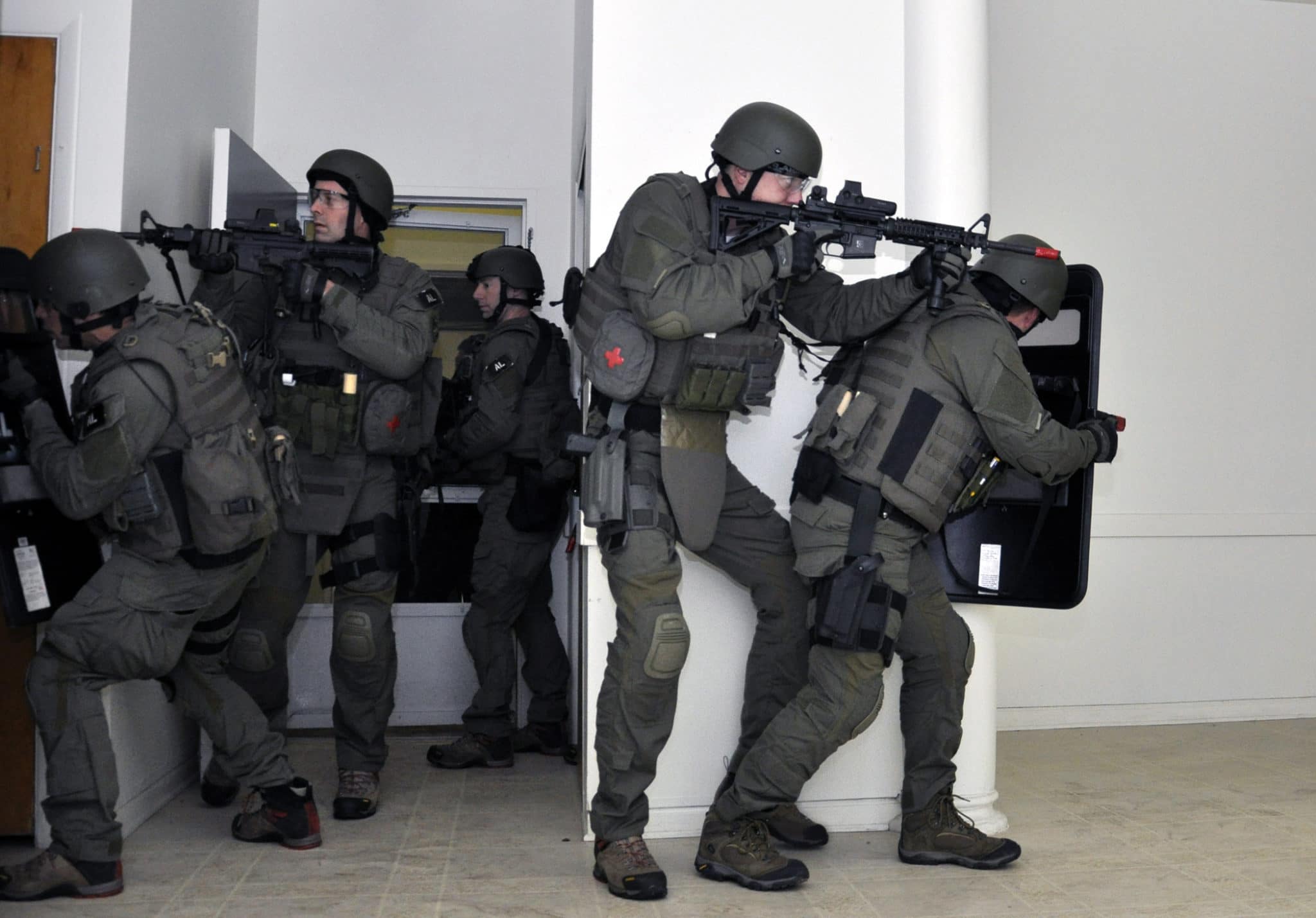It took the caught-on-camera murder of George Floyd by Minneapolis Police Officer Derek Chauvin—and weeks of massive street protests, clashes with police, toxic clouds of tear gas, rounds of plastic bullets, arrests of thousands of protesters, and looting of stores from Chanel to Target—to put notions from cutting billions from law enforcement budgets to outright abolition on the national agenda.
In an astonishing turn of events, every aspect of policing is suddenly being examined, criticized and challenged by the mainstream. The unchecked power of police unions, the unrepentant brutality and the near-total impunity when cops kill Black people, is what everyone is talking about.
Activists’ call to “defund the police” is finally being heard. But it’s not the first time demands to instead fund mental health, drug treatment, youth programs, healthcare, affordable housing, transportation—anything but the police—have been made. For decades, such calls have been met with a resounding no from city councils, mayors and governors. Allocating the money to hire “1,000 more cops” has never been contentious among politicians. But how often have you heard them take up a call to hire “1,000 more” school nurses, therapists or teachers?
Defunding and disarming police departments and diverting the money to long-term investments in civic and public health services in communities of color that have borne the brunt of policing-run-amok should be a no-brainer. It is long overdue social and racial justice.

The demonization of drugs, the state-sanctioned stigmatization and hatred of people who use and sell them, are an all-purpose pretext for police to use violence.
There is another taxpayer revenue stream that flows to law enforcement that must be completely cut off, not defunded: the War on Drugs. The 50-year-long drug war has a trillion-dollar price tag. It funds drug-warrior cops who disproportionately terrorize, traumatize, murder and maim Black and Brown people. The demonization of drugs, the state-sanctioned stigmatization and hatred of people who use and sell them, are an all-purpose pretext for police to use violence.
There are two ways this pervasive prejudice has aided law enforcement. When the police beat, kill, frame or cage for decades people who use or sell drugs, there is often, at least until recently, little community outrage or organizing. And when the police murder civilians, they often allege that the person was involved in illegal drug activity or were a threat because they were high on drugs.
This “drug exception,” the idea that it is acceptable to use violence against people who use and sell drugs, is invoked to justify the use of deadly force and to absolve the police from criminal charges. And it has worked. The police get us coming and going.
In the deaths of Ramarley Graham, Philando Castile, Breonna Taylor and too many others to name here, the War on Drugs gave police the “justification” to inflict lethal violence.
Breonna Taylor was killed in a botched “no-knock” drug raid. Special Weapons and Tactics (SWAT) officers fired a fusillade of bullets into her body as she slept. An investigation into SWAT operations found that they are disproportionately used in drug searches and that between 2010 and 2016, at least 81 people were killed. The American Civil Liberties Union found in a 2014 report that 42 percent of those subjected to SWAT search warrant raids were Black.
During the Black Lives Matter protests from Ferguson to Minneapolis in recent years, millions of people have seen for themselves how hyper-militarized policing has become. “Robo-cops” clad in body armor carry military-grade weapons and ride in armored vehicles and tanks. Black Hawk helicopters hover in the sky and drones collect surveillance data. Rallies and demonstrations have become war zones, with police as soldiers and protesters as enemy combatants.
According to the ACLU, “The militarization of American policing has occurred as a direct result of federal programs that use equipment transfers and funding to encourage aggressive enforcement of the War on Drugs by state and local police agencies.”
The War on Drugs creates thousands of points of contact between police and citizens.
The violence meted out to protesters is captured on cell phone cameras and instantly uploaded to social media. Video clips of swarms of police beating people, slamming them to the ground and putting them in white plastic handcuffs are viewed by millions. This kind of violence has been a daily reality for decades in poor communities of color in the name of the War on Drugs—but one that exists largely out of whiter, wealthier communities’ sight.
The War on Drugs creates thousands of points of contact between police and citizens. The policy of stop-and-frisk created contact on a mass scale. Since 2002, New Yorkers—overwhelmingly from Black and Latinx communities—have been subjected to police stops and street interrogations more than 5 million times. In 2011, under former Mayor Bloomberg, over 685,000 people were stopped. The arrests that result from these stops—most often for possession of small amounts of marijuana—destroy lives because criminal records negatively impact employment, housing and education opportunities.
The drug war enables police to steal from communities of color, too, by means of civil asset forfeiture laws. Civil asset forfeiture allows police to seize—and then keep or sell, in a grotesque conflict of interests—property they allege is involved in a crime. Owners don’t have to be arrested or convicted. Many of the seizures are allegedly drug-related, and low-income, Black and Brown communities are disproportionately targeted. This “policing for profit” generates millions of dollars annually that police departments come to depend on.
Gerald Bryan was one victim of a New York Police Department (NYPD) cash grab. He was charged with felony drug distribution and during a violent search of his home in 2012, the police confiscated $4,800 in cash. His money was deposited into the NYPD’s pension fund. “They do this all the time to so many people I know,” said Bryan, who lives in the Bronx. “A lot of people, when they get arrested, they know that their money is just gone, and they know that the police are taking it to enrich themselves.”
The opioid-involved overdose crisis is another point of contact with police. In 2017, more than 70,000 people died from drug overdoses, with 68 percent of those deaths involving a prescription or illicit opioid. The main response to this catastrophe has been to double down and expand the drug war. Police, in this context, are often first responders to an overdose scene—exposing victims and their families and friends to possession or far worse, drug-induced homicide charges.
The Drug Enforcement Administration (DEA) is a law enforcement agency that spearheads the drug war. Through its diversion control division, DEA agents have arrested dozens of doctors, pharmacists and others for illegal distribution of opioids, potentially cutting off a safer supply for people who want or need them. In addition, inexplicably, the DEA controls how methadone and buprenorphine are prescribed. It has not allowed the required massive expansion in access to the two medications during the overdose crisis, even though it is well documented that they save lives. Now is the time to strip the DEA of its control over these vital medications.
Problematic drug use is a public health matter, and over and over again we’ve heard, “We can’t arrest our way out of drug problems.” But that truth didn’t stop the Office of the Special Narcotics Prosecutor in New York City from establishing, in the 2000s, the Heroin Interdiction Team (HIT), the Narcotics Gang Unit and the Prescription Drug Investigation Unit. They coordinate with Street Narcotics Enforcement Units to arrest as many people as possible.
A sprawling drug-war ecosystem funnels billions of dollars into other sectors and offshoots of the carceral state.
The National District Attorneys Association Opioid Addiction Crisis Working Group advocates for drug-induced homicide laws that will ensure more people are incarcerated. They advise prosecutors to “treat every overdose death as a homicide and assign homicide detectives to respond to these scenes,” and have “every person in the chain of delivery criminally liable for an overdose death.”
The automatic response to the tragedy of overdose deaths is to give more power to the criminal justice system and to direct funding to a jumble of law enforcement agencies, even though they have completely failed to disrupt the heroin supply chain. With fentanyl-adulterated heroin still widely available, a staggering amount of people continue to die.
A sprawling drug-war ecosystem funnels billions of dollars into other sectors and offshoots of the carceral state: Drug courts, drug testing labs, GPS ankle monitoring manufacturers, prisons, jails, methadone clinics, recovery homes, the drug diversion program LEAD and the DEA. All have an ideological and financial investment in maintaining the status quo.
The War on Drugs is based on policing, even by many actors that don’t go under that moniker—from policing people on methadone by forcing them to come to a clinic six days a week to be observed swallowing medication, to drug court judges who send those who relapse back to jail, to a whole “E-carceration” and drug testing industries that police people’s physical movements and their urine! And it is fundamentally racist because it targets people of color.
Amid the current debates on defunding, abolishing or “reimagining” the police in general, we don’t have to reimagine the War on Drugs. We have to end it, and now is the time.
These demands would dramatically reduce points of contact with the police, view drug use as a public health issue and shift funding to noncarceral, harm reduction-informed drug treatment services. To be sure, these reforms won’t end racism. But they offer humane, evidence-based solutions to drug problems and take away many of the pretexts to kill and incarcerate people of color.
1. Abolish the DEA, the Office of National Drug Control Policy and the Office of the Special Narcotics Prosecutor, among others
2. Ban civil asset forfeiture
3. Ban SWAT no-knock drug raids in every state
4. Equitably legalize and regulate all drugs
5. Transfer drug-war funding to build a national, harm reduction-based system of substance use services that offers treatment on demand, as well as resources like sterile syringes, naloxone and drug-checking, and is free
6. Open safe consumption sites
7. Close drug courts
8. Close methadone clinics and create a pharmacy-based methadone prescription system
Top photo of an FBI SWAT team training in 2012 by US Army Materiel Command via Wikimedia Commons/Creative Commons 2.0.
Photo of a recent protest in New York by Helen Redmond.





Show Comments